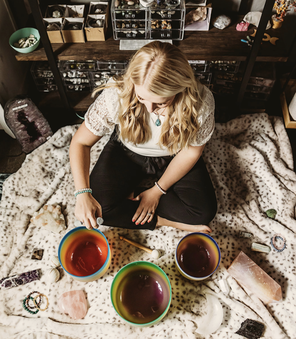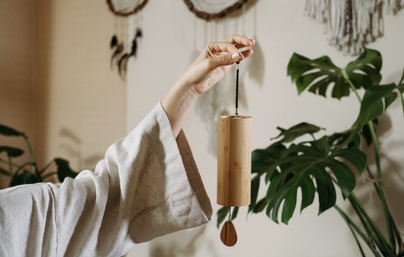Sound Baths & Sound Therapy
Sound is a powerful way for the body to relax, refresh and rejuvenate. Think of the way listening to your favorite song makes you feel? That is sound therapy. The idea that sound can make you feel or think certain things. Sound is frequencies and vibrations waves.
Sound Therapy is using sound to treat the body. To release blocks and stagnate energy in the chakras and mandarins. The way sound connects to the body allows the cells too reboot.
Sound Baths are made for the body to allow intentional sound therapy to enter the system and create movement and growth. Sound baths use items that are unique and designed for the body to create connection with you inner voice. It bridges the gap between body and soul.
First before understanding, let's dive into what is used.
Sound Therapy is using sound to treat the body. To release blocks and stagnate energy in the chakras and mandarins. The way sound connects to the body allows the cells too reboot.
Sound Baths are made for the body to allow intentional sound therapy to enter the system and create movement and growth. Sound baths use items that are unique and designed for the body to create connection with you inner voice. It bridges the gap between body and soul.
First before understanding, let's dive into what is used.
What instruments are used in Sound Baths?
Truth is, there is no right or wrong answer to this. Anything with sound. In a typical sound bath you would see or hear these items.
- Crystal Singing Bowls
- Chimes
- Gongs
- Tuning Forks
- Drums
- Voice/Singing
- Shakers
- Brass/mental singing bowls
- Crystal Singing Bowls
- Chimes
- Gongs
- Tuning Forks
- Drums
- Voice/Singing
- Shakers
- Brass/mental singing bowls
Sound is the way for the soul to connect with the body.
Taking time for yourself is not self-ish its important. Allow self-care to be a ritual in your every day life.
How does sound therapy affect people?
Sara Auster does an amazing job explaing how you might respond to sound thearpy in her book.
"Sound affects us psychologically as well as neurologically. When people hear the term
"sound therapist, certain conditions come to mind, varied as they might be. Here's a bit explanation of each. None of these things interferes with your ability to get the most out of a Sound Bath, but each reinforces the idea that we all interpret sound differently.
Synesthesia: In people with this condition, the senses are blended: a sight can trigger a smell, a number might be associated with a color. The word "synesthesia" comes from the Greek syn for "together" and the root aisthe, "to feel." People with synesthesia often don't realize at first that they have it--they think everyone sees red when they hear a trumpet, for instance. Occasionally a Sound Bath participant might come up to me after a session to tell me about the colors they saw as they listened.
ASMR: This stands for autonomous sensory meridian response and its prevalence sparked a trend in videos meant to trigger it. Some people get a specific, pleasant emotional and physical feeling from certain stimuli (often sounds), such as whispening voices, paper tearing, or scalp massage. It's been described as a feeling of well-being combined with a tingling sensation in the scalp and down the back of the neck.
Tinnitus: Unfortunately, no one who has tinnitus finds it pleasing. It's a sensation of noise (such as a ringing, buzzing, or roaring, like traffic or the ocean) that can only be heard by the person affected. It's not a condition itself, but a symptom of a condition--whether hearing loss due to prolonged exposure to loud sounds or age, an ear injury, a circulation disorder, or even impacted earwax."
Really the only way to know is to try one out for yourself.
"Sound affects us psychologically as well as neurologically. When people hear the term
"sound therapist, certain conditions come to mind, varied as they might be. Here's a bit explanation of each. None of these things interferes with your ability to get the most out of a Sound Bath, but each reinforces the idea that we all interpret sound differently.
Synesthesia: In people with this condition, the senses are blended: a sight can trigger a smell, a number might be associated with a color. The word "synesthesia" comes from the Greek syn for "together" and the root aisthe, "to feel." People with synesthesia often don't realize at first that they have it--they think everyone sees red when they hear a trumpet, for instance. Occasionally a Sound Bath participant might come up to me after a session to tell me about the colors they saw as they listened.
ASMR: This stands for autonomous sensory meridian response and its prevalence sparked a trend in videos meant to trigger it. Some people get a specific, pleasant emotional and physical feeling from certain stimuli (often sounds), such as whispening voices, paper tearing, or scalp massage. It's been described as a feeling of well-being combined with a tingling sensation in the scalp and down the back of the neck.
Tinnitus: Unfortunately, no one who has tinnitus finds it pleasing. It's a sensation of noise (such as a ringing, buzzing, or roaring, like traffic or the ocean) that can only be heard by the person affected. It's not a condition itself, but a symptom of a condition--whether hearing loss due to prolonged exposure to loud sounds or age, an ear injury, a circulation disorder, or even impacted earwax."
Really the only way to know is to try one out for yourself.



